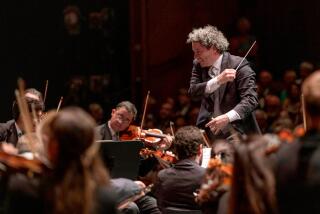L.A. Phil board Chairman David C. Bohnett keeps his ears tuned
David C. Bohnett, an Internet technology entrepreneur and busy philanthropist, serves on the boards of the Los Angeles Philharmonic Assn., the John F. Kennedy Center for the Performing Arts, amfAR: The Foundation for AIDS Research, the Los Angeles County Museum of Art and his own eponymous foundation. The L.A. Phil board chairman for the last five years discussed his involvement with the orchestra since Walt Disney Concert Hall’s opening a decade ago.
How long have you served on the L.A. Phil board and why did you choose to work with them?
I grew up in Chicago and I came [to Los Angeles] as an 18-year-old and have very fond memories of hearing a wide variety of performances at the Bowl and also going downtown to the Dorothy Chandler Pavilion. But for a long time I eschewed a lot of involvement in the culture of the performing arts, feeling that my time and talents were better served in the social services and social justice arena. When Walt Disney Concert Hall opened, I thought, wow, this is a very big deal. This is a major signature piece of architecture for the city. It’s something that will further propel the development downtown and unite us, so I signed up as a major sponsor for all three opening nights 10 years ago, and I took 10 friends for each of the opening nights. That raised my profile significantly, and I was asked to join the board. By that time, my thinking had evolved, because I thought I could really see a role for me bridging social justice and the cultural arts through outreach to underserved communities.
INTERACTIVE: Disney Hall inside and out
Can you talk about how you’ve worked for social justice with the L.A. Phil?
Our youth orchestra program in underserved communities is something I’ve been a champion of since Day One, and that’s been a board-led effort in terms of allocating the funding; it’s a major commitment for the institution to invest in these communities.
How much does the board spend on that?
The institution spends approximately $3.5 million in our education budget per year. That goes to the entire spectrum of our education programs — community concerts, bringing kids into the concert hall, going out to schools. And then our three youth orchestra programs. Beyond that, recruiting Gustavo Dudamel, of course, was a way of demonstrating that we strive to be an institution that represents all Angelenos, and his background has arguably significantly raised our visibility in certain minority communities. And the fact that his programming is really intended to broaden the repertoire of music that we present, particularly at the Bowl — the Americas and Americans festival, presenting works from Latin America, North and South America is one example.
TIMELINE: Walt Disney Hall through the years
I’m sure you know that symphony orchestras around the country are struggling with dwindling audiences. Is part of your marketing strategy to grow audiences?
Our audience outreach is programming and especially maintaining the accessibility of the Bowl. It’s really important for us that there are bench seats in the back that are available for a dollar. Now with the screens, arguably it’s just as great in the back as it is in the front.
Have you learned anything more about Dudamel in traveling with him?
It sounds corny, but music is truly universal and his appeal is universal. I’ve been in Paris and Berlin and London and Caracas and New York and Washington, all over, and it’s a consistent reaction people have — it’s a wow factor for him that people haven’t experienced before.
PANORAMA: Inside Walt Disney Concert Hall
What’s the board’s position on commissioning new works, and how does it work with the Phil’s staff to achieve that?
We welcome all manner of investment in contemporary music. Lennie and Bernie Greenberg, for example, have for decades commissioned new works and have had a long, long relationship with [composer] John Adams, for example. And what happens is that board members express an interest and work with the artistic leadership of the Philharmonic — [artistic planning vice president] Chad Smith and Deborah [Borda] — to find common ground between what the board member’s interest is and what the institution’s connections are to young composers. It’s a very collaborative process, and it has been very successful. A lot of that is because we have a culture of new music and, as Gustavo says, we have the culture of the new. We’re not hidebound in terms of playing all the war horses.
What does the David Bohnett Foundation do?
We focus on four or five key program areas that I group around social change and social justice. A lot of the work is also matched by work on the political side that I do separately from that. We’re unfortunately one of the few stalwart longtime funders, along with the Broad Foundation and the Joyce Foundation in Chicago, of anti-gun violence efforts. Number two, [the foundation supports] socially responsible mass transportation efforts focused on Los Angeles in particular. Gay and lesbian activism, gay and lesbian civil rights, we’re a big funder in marriage equality efforts over many years.
FULL COVERAGE: Walt Disney Concert Hall at 10
Do you have long-range goals for the L.A. Phil?
Financial stability is the goal, and maintaining the level of artistic excellence. And showing that the music is accessible to as wide a variety of people as possible. One of my semi-frustrated efforts that I will continue to work on is to broaden the outreach through new media and social media; it’s been very difficult to do that because of some of the union contracts.
More to Read
The biggest entertainment stories
Get our big stories about Hollywood, film, television, music, arts, culture and more right in your inbox as soon as they publish.
You may occasionally receive promotional content from the Los Angeles Times.










